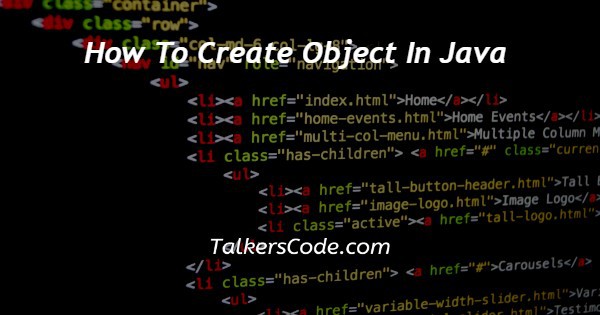In this article we will show you the solution of how to create object in java, a language with OOPs relies on objects as its foundation. The Java language requires the creation of objects in order to execute a program.
Our discussion in this section will cover various methods of creating Java objects, as well as how to make a Java object.
When creating an object or instance of a class, the new keyword is most commonly used.
A new instance of the class is created by using the new keyword, which allocates memory (heap) and returning the reference to that memory for the newly created object.
Arrays can also be constructed using the new keyword. We will now discuss the idea of how to create object in java with an example.
Step By Step Guide On How To Create Object In Java :-
import java.io.*;
public class TalkersCode Employee {
String name;
int age;
String designation;
double salary;
// This is the constructor of the class Employee
public TC Employee(String name) {
this.name = name;
}
// Assign the age of the Employee to the variable age.
public void EmpAge(int EmpAge) {
age = EmpAge;
}
/* Assign the designation to the variable designation.*/
public void EmpDesignation(String EmpDesign) {
designation = EmpDesign;
}
/* Assign the salary to the variable salary.*/
public void EmpSalary(double EmpSalary) {
salary = EmpSalary;
}
/* Print the Employee details */
public void printEmployee() {
System.out.println("Name:"+ name );
System.out.println("Age:" + age );
System.out.println("Designation:" + designation );
System.out.println("Salary:" + salary);
}
}
- A Java input/output library needs to be imported in order to get started.
- As you can see in the code below, we declare a public class called "TalkersCode Employee". The main functionality of our application can be found in this class.
- Here are some variables we declare as instance variables. This is where each employee's information will be stored. A string variable represents the name, an integer variable represents the age, a string variable represents the designation, and a double variable represents the salary.
- Creating the constructor of the class is the first step. A constructor is an object-creating method in Java that gets called when a new instance of a class is created. This is where the object's variables are initialized. In this case, the constructor takes as input a string argument named "name" and assigns it to the instance variable "name".
- Our next step is to create some methods for setting the values of the instance variables. "EmpAge", "EmpDesignation", and "EmpSalary" are the three methods that make up this method. Assigning an appropriate instance variable to an argument of the appropriate data type occurs in each method.
- Printing out the details of each employee can be achieved by creating a method called "printEmployee". Using this method, you will be able to print out the details of each employee formatted according to your preferred method using the "System.out.println" method.
- Once our class declaration is complete, we may proceed to the following phase.
Conclusion :-
As a result, we have successfully learned how to create object in java with an example.
The goal of this tutorial was to show you how to create an object of a class in Java using multiple example programs.
You ought to be able to design your own class objects as soon as you have a handle on the fundamentals.
I hope this article on how to create object in java helps you and the steps and method mentioned above are easy to follow and implement.














